The incident named "Anagni
slap" occurred between 7th and 9th September 1303, and consisted
in the arrest and emprisonment of pope Boniface VIII, in his palace
of Anagni, a town about 65 km (40
Mi) south of Rome, now in the province of Frosinone, by the emissaries
of the king of France Philip IV,
called "Philip the fair" (1268-1314) with the help of members of some
Roman noble families, the Colonna
above all.
The episode was a part of the harsh power struggle at the turn
of the 14th century between the king of France
and the leader of the Church of Rome, both of which had very strong
personalities, and were ambitious and determined to safeguard
by all means the institution they leaded. Bonifacio tried to defend
the spiritual supremacy of the papacy against the pressing imperialism
of France, but in spite of his high political and diplomatic skill,
the contest soon became an open clash and the military dominance
of the French prevailed, culminating precisely with the Anagni
incident, causing the end of Boniface and the temporary transfer
of the papacy to Avignon.
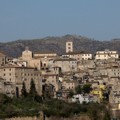
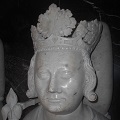
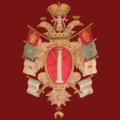
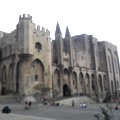
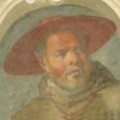
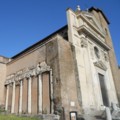
Benedetto
Caetani
The pope was born
between 1230 and 1235 with the name Benedetto Caetani at Anagni,
the city of three other popes (Innocent III, Gregory IX, and Alexander
IV), where he resided for a long time, also after the election
to the papacy. His father Roffredo and his mother Emilia Giffridi
from Guarcino. According to some sources, his mother was the sister
of Leonardo Patrasso, appointed
cardinal by the same Boniface in 1300, but probably he was only
a relative, Roffredo and Emilia had many children, of which Benedetto
was the only one to follow the ecclesiastical career. He followed
studies of canon law in Spoleto and Todi, where his uncle Pietro
Caetani was bishop, and in Bologna. He later recalled with great
affection both Todi and Bologna, in which he took part assiduously
in the city political struggles, always siding with the Ghibellines.
Benedetto was a consistorial lawyer, and in 1264 he accompanied
as secretary Cardinal Simon de Brion, the future pope Martin IV,
in Paris, and in 1265-1267 Cardinal Ottobono Fieschi, the future
pope Adrian V, in England. He was apostolic prothonotary from
1276 and intervened in the negotiations of Cardinal Matteo Orsini
with Rudolf I of Hapsburg and Charles of Anjou in 1280 (Miranda).
On April 12th, 1281 pope Martin IV made him
cardinal deacon with the title of San
Nicola in Carcere Tulliano, so he became a diplomat highly
appreciated by the Roman Curia. Benedetto was instead ordained
priest only on September 22nd, 1291, when he was around sixty
years old, and three years before his election as pope. On that
day he was also ordained bishop and obtained the title presbytery
of Saints Silvestro and Martino ai Monti (Miranda).
Caetani was highly regarded as a diplomat, so that pope Martin
IV defined him "a man of profound judgment, reliable,
with great foresight, diligence and prudence" (Paravicini Bagliani,
2003). He was entrusted
with several diplomatic missions, to London, Denmark, France and
various locations of Italy. He was a papal legate in Sicily and
in Portugal, and settled disagreements between the king of Sicily
and Alfonso of Aragon and between Philip the Fair and the king
of England Edward I (Vaccolini).The contemporary historian Ferretto
Vicentino defined him "prudent and astute" (II, 63,24).
In November 1290 Benedetto Caetani harshly intervened in Paris
in a dispute that he had been called to arbitrate as papal legate,
standing up for the mendicant religious orders against eminent
bishops and teachers in Paris University, which he severely accused
of poor doctrine, presumption and lack of intelligence. He uttered
a very suggestive phrase about his concept of the Church of Rome:
"the world has been entrusted to our care, we must not
worry about what can please you, not about you wise men and about
your tantrums, but we care of what it's useful to the whole universe".
During this mission Benedetto met Philip the Fair, with whom
a relationship of mutual esteem and respect began. Caetani at
the time was called "gallicus", meaning
he was considered a friend of the Frenchmen, those of the motherland,
but also the Anjou who ruled in Naples, so that he was reprimanded
for this by his own brothers, as he himself used to tell.
During his career as a prelate, according to the custom of the
time, he was able to collect considerable wealth, proceeding from
the prebends to which he was entitled for his religious offices,
and from the gifts he received for his engagement in procedures
or mediations. This income allowed his family to amass power and
possessions in the central and southern Latium, both through the
huge amount of money he owned, and by the action of threatening
conviction he was able to exercise.
Boniface payed a very special attention to his own image, which
was unusual for the time: he commissioned portraits to great artists
or solicited them their execution, among them the one contained
in the fresco of the Roman basilica
of St John Lateran, attributed to Giotto, representing the convocation
by Boniface of the Jubilee of 1300. Among the statues we count
the works by Arnolfo di Cambio in the Museo dell'Opera del Duomo
in Florence, the statue (1290)
and the bust (1298, see the cast
from Anagni pope's palace), the two statues of Orvieto (1297),
one by Ramo di Paganello
and the other, maybe of Rubeus,
the one from Bologna by Manno
di Bandino (1300) and that of an unknown author on the left side
of Anagni Cathedral, that
according Fedele (1921b) was probably erected by the people
of Anagni after his death, in order to atone for their participation
in the aggression.
Before him it was not usual to portray the popes in statues, with
the exception of Nicholas III (1216-1280), to whom the city of Ancona had
dedicated a statue in gratitude. Other possible portraits of Bonifacio
are inserted into architectural elements, such as the
one attribuited to Arnolfo di Cambio. This iconographic abundance
after his death even earned him the accusation that he made himself
idolise.
Boniface explained to her physician Arnaldus de Villa Nova the
reasons for such an attention to his image, motivated by the desire
to increase the glory of the Church of Rome and to perpetuate
the memory of himself in the centuries "we have enlarged
the glory of the Church of Rome, among so much gold and so much
silver, and in front of these and those, and for this reason our
memory will remain glorious for ever and ever" ("Nos
auximus gloriam ecclesie Romane in tanto auro et in tanto argento
et in hiis et in illi, et ideo nostra memoria erit in seculum
seculi gloriosa") (Fedele, 1921b).
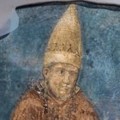
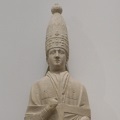
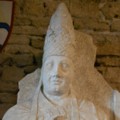
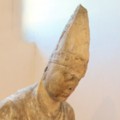
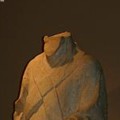
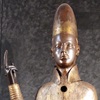
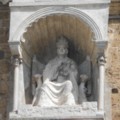
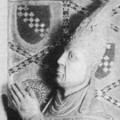
The election
as pope
On December 24th,
1294, the second day and third scrutiny of the Naples Conclave,
held in Castel Nuovo after the renunciation
of the throne of Celestine V, who
had been pope for 107 days, Benedetto
Caetani was elected as pope
(see his coat of arms). Although
not reaching the unanimity, he had the support of a vast majority
of cardinals, including two members of the Colonna family, Giacomo
and Pietro (uncle and nephew), who later became his bitter enemies.
His election was seen favorably by all the European ruler, including
Philip the Fair, who sent him luxurious gifts. After his election
to papacy, on 1st or 2nd January, 1295 Boniface went to
Roma to be crowned, and brought back the papal seat from Naples
to Rome, even though he often moved to Anagni, especially in summer,
to escape the Roman heat, but especially to avoid malaria (Giammaria, 1983). Vaccolini refers of a coronation
showing a pomp never seen before. The pope, during the procession
from St. Peter to St John Lateran was riding a white steed, and
was served to get into the saddle by the kings Charles of Sicily
and Charles Martel of Hungary, who held the bridle of his horse.
On February 22nd, 1300 Bonifacio established the
first Jubilee, which provided for the plenary indulgence for those
who visited the basilicas of St. Peter and St. Paul. The Holy
Year was perhaps convoked following the spontaneous flux of pilgrims,
drawn to Rome by the rumours of a plenary indulgence on the occasion
of the beginning of the century (Giammaria, 1983), but according to others, perhaps influenced
by contemporary situations, Boniface conceived the Holy Year pushed
by the craving of gains. In any case, the Jubilee saw the flow
in Rome of an unexpected number of pilgrims: according to the
chronicler Giovanni Villani (IX, 36),
who was among the participants, they were 200,000, not counting
those who just passed there. Because of the crowd of pilgrims
on Sant'Angelo bridge two separate
lanes for each direction were established for pedestrians, as
also cited by Dante Alighieri in the Divine Comedy (Inferno, XVIII,
28-33).
On June 6th, 1303, by the bull "Supremae
praeminentia Dignitatis" Boniface founded the "Studium
Urbis", the first Roman University, which later became
known as "la Sapienza".
The pope also instituted other universities, that of Pamiers
(December 18th,
1295) mainly used
as a political instrument against Philip the Fair (Théry), and those of Fermo (January
16th, 1303) and Avignon (July 1st,
1303).
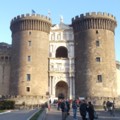
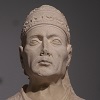
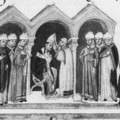
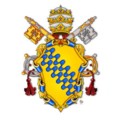
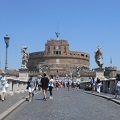
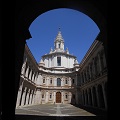
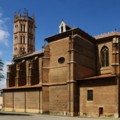
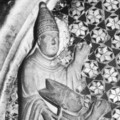
Celestine V in his brief
pontificate had bestowed appointments, privileges and rents on
many postulants and flatterers often unworthy, but at the moment
to abdicate, realizing the damage done, he had asked his successor
Bonifacio to revoke them. The new pope quickly annulled many appointments
and privileges granted by his predecessor, damaging especially
several members of Colonna family, which engendered further conflicts
and resentment between the two families.
Moreover, after his election to the papal throne, Boniface VIII
granted the Caetani additional power, going too far with nepotism,
which anyway was a very common practice at that time: actually
Boniface appointed as cardinals three of his nephews, Benedetto
and Francesco Caetani, sons of two of his brothers and Giacomo
Caetani Tommasini (portrayed with him in the tabernacle
lunette attribuited to Arnolfo di Cambio), his sister's son,
who were all very young (Benedetto was probably eighteen). Nepotism
is nowadays considered one of his major mistakes as pope, beyond
the invective and calumnies spread by those who had grievances
against him, as Philip the Fair, Dante Alighieri
and Jacopone da Todi (1236-1306)
who had called Boniface
VIII "new Lucifer" (83: 51).
Boniface's
character
The chronicler Giovanni
Villani so described him: "he was highly magnanimous and
refined, and wanted much honor, and knew well how to maintain
and advance the rights of the Church, and for his knowledge and
might he was greatly respected and feared; he was much wealthy
in order to make the Church and his relatives greater, not having
any concern about gaining, since he used to say that for him everything
that was in the Church was lawful " (IX: 6).
Anyway on several
occasions Benedetto Caetani still proved to have a difficult character,
excessively impulsive, irritable, resentful and touchy; in his
court it was known that he hated to be contradicted, and that
when this happened, he used to react with great vehemence.
In the Annales Genuenses by Giorgio and Giovanni Stella
an episode which occurred on an Ashes Wednesday is reported: the
Archbishop of Genoa Porchetto Spinola (dead 1321), of the Order
of Friars Minor, appointed by the same Boniface in 1299, being
in Rome asked the Pope to place the repentance Ashes on him. Boniface,
instead of putting the Ashes on Spinola's forehead, would have
thrown them into his eyes, pronouncing a parodic version of the
ritual formula: “Remember that you are Ghibelline, and
to dust you shall return with Ghibellines”. Boniface
would have even whitdrawn to Spinola the episcopal dignity, deeming
he had given hospitality his bitter enemies, the Colonna cardinals
(Paravicini
Bagliani, 1994) or
Spinola would have resigned pressed by the pope, which was not
sure he was trustworthy enough on the political issues that were
on the playing field (Bezzina).
The irritability of Benedetto Caetani could also result from the
physical problems from which he suffered, especially kidney stones.
The pope was treated by the Catalan doctor and alchemist Arnaldus
de Villa Nova (Arnau de Vilanova, 1240-1313) who was also the physician of
King James II of Aragon and professor at the University of Montpellier
and at the Schola Medica Salernitana
(Frale). At the end of July 1301 Arnaldus
would have shut himself in the church of San
Nicola, above the village of Sgurgola,
in front of Anagni, in order to develop a golden astrological
seal, packed into a leather belt, to cure the pontiff. It seems
that the therapy was successful, perhaps for a simple mechanical
effects on the kidneys of the leather belt, allowing the alchemist
to get a generous reward from the pope and arousing great envy
and resentment against him in the papal court. Boniface also supplied
himself with water from the spring
that still bears his name in Fiuggi (then named Anticoli), about
20 km from Anagni. Perhaps the miniature
on parchment depicting a pope who receives an elixir, while
a fox tries to steal his tiara, portrays Boniface, although the
work of Girolamo da Cremona was painted more than a century and
a half after his death.
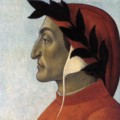

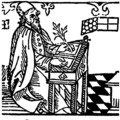
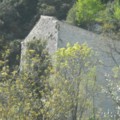
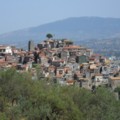
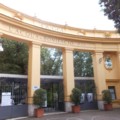
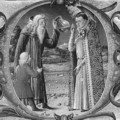
The rivalry
with the Colonna
As seen in the previous
paragraphs, among the Colonna and Caetani families a deep rivalry
arose, mainly due to the proximity of their respective fiefs south
of Rome. The Caetani were rapidly climbing, thanks to the election
to the papacy of Boniface VIII. However, the two Colonna members
of the College of Cardinals, after having supported the election
of Benedetto Caetani, also collaborated with him in good harmony
in the first two years of his pontificate. This harmony was broken
by the continuous expansion of the Caetani and by the reaction
of the Colonna, materialized by the event that occurred on May
3rd, 1297 on the Appian Way, near Cecilia
Metella tomb, transformed into a fortress
with the name of Capo di Bove (due to the bucrania,
i.e. ox skulls, that still adorn it). Pietro II Caetani, the pope's
nephew, was carrying from Rome to Anagni a part of the treasure
of his uncle, donated in the occasion of the election to the papacy
by European kings and princes, amounting to 200,000 gold florins,
contained in eighty sacks carried on mules' rump. The treasure
was robbed by a group of armed men led by Stefano Colonna, brother
of Cardinal Pietro and nephew of Giacomo, probably with the aim
of preventing the Caetani from buying other properties, increasing
even more their power. A wrathful Boniface VIII summoned the Colonna
cardinals to answer for the outrage, but the two at first didn't
come, then came and received the conditions for forgiveness, including
the return of the treasure, which happened a few days later, probably
by the intervention of the two Colonna cardinals on Stefano.
The war between the families, however, didn't stop, the pope appealed
to the Romans denouncing the injustice suffered and omitting to
mention that the treasure had been given back. The Colonna, summoned
to declare whether they recognized the legitimacy of Boniface
as pope, gathered instead with a group of people, including somebody
not belonging to the family, as Jacopone da Todi, at Lunghezza
castle, 20 kilometers from Rome, owned by the allied Conti
family.
From the castle, on May 10th, 1297, they replied with a harshly
argumentative declaration against the pope, the Lunghezza Manifesto,
posted on the doors of the churches of Rome and on the high altar
of St. Peter's basilica, in which Boniface was accused of ruling
tyrannically, and especially of having forced Celestine V to resign
as pope: in consequence of this Boniface was to be considered
an usurper, and all his acts were to be considered null and void.
Thus the Manifesto responded to the explicit request by Bonifacio
to be recognized as pope, saying: "vos non credimus legitimum
papam esse" (we do not believe you are a legitimate pope) (Fedele, 1921b).
Again the pope reacted by denouncing the outrage in front of the
Roman people, but the Colonna publicized on May 16th
a new document, in which he was accused of further abominations,
including that of having ordered the murder of Celestine V. Also
this accusation was functional to the attempt to delegitimize
Boniface as pope, and it was very successful, as to be often considered
a known fact. The accusations and claims of the Colonna were based
on those of the movement of the Spiritual Franciscans, supported
by Celestine V, and strongly critical towards Boniface VIII.
The pope excommunicated the two cardinals with the bull "In
excelso throno" issued on May 10th,
1297, in which he condemned the Colonna and the outrages of their
"damned race and their damned blood" who "raised
at all times their head full of arrogance and contempt"
(Bassetti) and, therefore, even deserved
extermination. A few days later, after
a resentful reply of the Colonna, Boniface promulgated on May
23rd, Ascension Day, the bull Lapis abscissus,
with which he confirmed the excommunication of the two cardinals
and extended it to other Colonna, Stefano and prince Giacomo (known
as Sciarra for his quarrelsome character), both brothers of Pietro,
Agapito and Oddone, as well as Jacopone da Todi; moreover, it
ordered the confiscation of the family properties and ordered
to all the faithful to catch them.
On June 15th, the Colonna reaffirmed the illegitimacy
of the pope and appealed to the people to call a council aimed
to elect a new pope. Boniface replied putting Dominicans and Franciscans,
endowed with power of inquisition, to pursue the Colonna, justifying
this arduous decision by the accusations of heresy thrown against
them. Moreover, the pope recruited soldier by his allies in many
municipalities in central Italy (including Siena and Florence),
also with the help of bankers and cardinals, with funds deriving
from religious and military orders, including the Templars.
On July 21st the pope got such forces to conquer
the castle of Colonna, the town from which the family took its
name, and to assault several other properties of the rivals, including
Nepi, Tivoli, Palestrina, Zagarolo and various properties of the
Colonna in Rome. After a failed attempt of mediation by a member
of the Savelli family, the pope retired himself to Orvieto, where
on September 4th, 1297 sanctioned a real crusade
against the Colonna, granting indulgence to those who would die
fighting against them. Boniface entrusted Theodoric of Orvieto
(Theodorico de' Ranieri, 1235-1306), Archbishop of Pisa, to conduct
the military operations. In 1298 the castle and the village of
Colonna were finally destroyed and the pope on June 21st
issued a bull which forbade its reconstruction. In autumn 1298
the two Colonna cardinals were in Rieti to beg mercy from the
pope, who received them wearing the pontifical vestments and the
tiara, as the pope himself told in the bull of October 3rd,
1299 (Fedele,
1921a). The pope assigned
the two cardinals to a kind of confinement, from which the two
prelates walked away, moving over through Italy, then, taking
with them all the defamatory material collected against Boniface
VIII, they took shelter in France, where they found themselves
in 1303, the year of the slap. In September or October of 1298,
following a truce not respected by the rivals, the pope ordered
Theodoric of Orvieto, who in the meantime had also became chamberlain,
to completely destroy Palestrina, which belonged to the Colonna,
"so that nothing remains, not even the status or the name
of a city". The men of Bonifacio, led by Landolfo Colonna,
brother of Giacomo, along with a contingent of Florentine troops,
destroyed the city, leaving only the cathedral standing up, then
he ran the plough and salted the earth on the ruins of the city.
Among the prisoners captured in Palestrina there was Jacopone
da Todi, who was expelled from the Franciscan Order of Friars
Minor, excommunicated and imprisoned in the basement of the Franciscan
convent of San Fortunato in Todi. Dante, in his Divine Comedy
(Inferno,
XXVII, 91-111)
ascribes to Bonifacio
the guilt of having induced Guido da Montefeltro to advise him
on how to conquer Palestrina fraudulently, leading him to eternal
damnation. The pontiff got to rebuild on the ruins a new city,
called Papal City ("Civitas Papalis") (Fedele, 1921b) and on June 13th,
1299 appointed Theodoric of Orvieto as bishop of the city. (Bassetti)
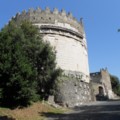
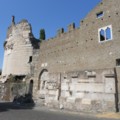
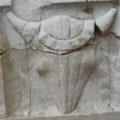
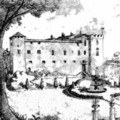
The clash
with Philip the Fair
The clash between
the pope and the king of France actualized itself in a surge of
hostile acts and reciprocal retaliation: in January 1296 Philip,
in order to finance the war against England, which had begun two
years before, had imposed an extraordinary tax of 2% on properties,
including the ecclesiastical ones, which until then were subject
only to the taxation of the Roman Curia. Boniface could not accept
this blitz and the following February 25th
issued the bull Clericis laicos, prohibiting, on pain of
excommunication, all the members of the clergy, not only French
(also Edward I of England had taxed the ecclesiastics), from paying,
without the consent of the pope, any tax to the kings, who in
turn had to ask permission of the pope to impose taxes on the
clergy. The countermove of Philip was the prohibition of transferring
outside of France any luxury goods and money, and therefore also
the taxes destined to Rome.
On September 20th, 1296, the pope replied very
harshly, with the bull Ineffabilis amoris, in which a real
ideological edict, prophetic in nature, appears: "You
must know that We and our brothers, if God gives us the strength,
we are ready not only to undergo persecution, destruction and
exile, but also to sacrifice our lives for the ecclesiastical
freedom and liberty"
(Paravicini
Bagliani, 2003).
The conflict then saw a temporary cooling, thanks to conciliatory
steps taken by both sides, including the canonization, on August
11th, 1297 in Orvieto, by Boniface, of the late
King of France Louis IX, a grandfather
of Philip the Fair, with the name of San Luigi dei Francesi (St.
Louis of the French). Hostilities resumed in 1301 with the case
of Bernard Saisset, bishop of Pamiers, a town at the foot of the
French Pyrenees, which for years had been in a powers conflict
with the local lord, the Count of Foix. Saisset had turned to
the pope at that time, Nicholas IV, who had put the properties
of Saint-Antonin di Pamiers
abbey under the protection of Benedetto Caetani, at the time Cardinal.
Philip the Fair intervened
in a heavy way in September 1301 ordering to arrest and take to
trial the bishop, a power reserved to the Church, thus violating
the ecclesiastical immunity. The charge was highly serious: betrayal
of the king and crime of treason, for having sought the support
of the pope, not recognizing the sovereignty of the king, and
even accusing him of heresy; the trial mimicked procedures and
terms of the ecclesiastics ones.
Boniface fueled the retaliatory spiral with a series of bulls
issued between 4th and 6th December, 1301: the Secundum
divina, that exhorted the king to free Saisset "not
to offend the majesty of God", since the laymen had no
jurisdiction over the religious persons; the Salvator mundi,
that suspended the privileges granted in the past to the king,
the Ausculta filii, published on December 5th,
1301, that warned the king of France for disobeying the pope (Théry), and finally the Ante promotionem
nostram, that summoned in Rome for November 1st,
1302 all ecclesiastical and theological authorities of France,
for a real synod on the safeguarding of religious freedom, threatening
to excommunicate the king if he had prevented the French bishops
from taking part in it. Overall, the pope created the conditions
for a deep disturbance in the internal affairs of the French monarchy
(Dupré
Theseider). Philip,
after consulting with the French nobility and clergy, decided
to go against the pope's attempt to impose its temporal and spiritual
dominion of the Catholic kings, and circulated the text of a falsified
papal bull, offensive against the king and France, to trigger
the popular indignation against the pontiff.
As Boniface took note that about half of the French bishops hadn't
reached Rome, he issued an excommunication for anyone who had
prevented any priest from reaching the council and on November
18th, 1302 issued the bull Unam sanctam,
with which he aimed to impose the papal supremacy over all kings
of the earth.
According to the chroniclers Giovanni Villani and Dino Compagni,
Boniface tried to undermine the power of Philip the Fair favoring
his enemies, the Flemings, who had defeated him on July 11th,
1302 in the Courtrai battle and the
Germans, and combating his allies, such as the Angevins.
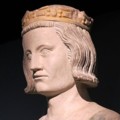
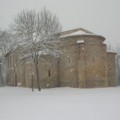
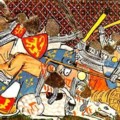
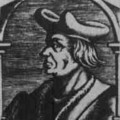
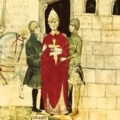
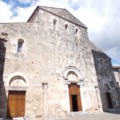
The preparation
of the attack
Philip IV reacted
to the papal bulls convening a council against Boniface, which
he defined as "simonist and heretic", moreover
accusing him of having evoked the demons and of inducing the people
to worship him. Therefore he sent his counsellor, the jurist Guillaume of Nogaret (1255-1314) to Anagni
in order to arrest him, According
to others the whole endeavour of Anagni was actually an idea of
Nogaret, that he suggested to Philip IV in February of that 1303.
Other historians doubt that Philip had ordered the attack, although
he probably knew it would have occurred. It seems that the pope
had prepared the excommunication bull Super Petri solio,
that had to be promulgated on Sunday, September 8th,
1303, the day after the assault, posting it on the gates
of Anagni cathedral. This could be the real reason that led
Nogaret and his group to assault the papal palace of Anagni, destroying
the copies of the bull (however the text is still known by transcriptions
made probably at the time).
On March 7th Nogaret received a coded message
of the Royal Chancery in which he was ordered to "go to
that certain place ... and do what will seem good to you",
and on March 12th, during a solemn assembly held
in the gardens of the Louvre royal palace, the counselor gave
a speech in which he harshly attacked the pope, listing his faults,
including that of having forced Celestine V to abdicate, and of
being a heretic, and demanded the convocation of a general council
to review his case, and then to take the pope to trial.
Nogaret, defined by Nangis a soldier and a jurist, put together
a team of 300 men (Villani), or according to the manuscript
of Vienne (Digard) 1,650,
of which 1,050 were foot soldiers and 600 mounted soldiers. The
force was composed of Frenchmen and Italians, belonging to the
families hostile to the Caetani, and therefore mainly to the Colonna,
thus exploiting of the rivalry between the two families, and being
spurred by the bribes payed by the French (Giammaria, 2004). Nogaret's troops probably had
their base at Staggia Senese castle,
near Siena, today in the municipality of Poggibonsi, owned by
the Florentine merchant Musciatto Franzesi, an advisor of Philip
the Fair, who would have provided funds for the raid. The soldiers
who took part in the expedition were from Anagni and neighboring
towns, such as Alatri, Ferentino and
Ceccano, damaged by the expansionism
of the Caetani (Giammaria,
2004). The squad left
from Rome, being led by Nogaret, with the insignia of the king
of France, and by Sciarra Colonna. According to the tradition,
before bursting at dawn into Anagni, the conspirators gathered
in Sgurgola (see my
webpage) a village about 10 km (6.2 Mi) from Anagni, where
they were harangued by Giordano Conti, standing on a stone located
at the entrance of the village, therefore called the "wicked
stone" ("petra réa"). Conti was spurred
by his hatred for the pope, who had dispossessed him of his properties
in Sgurgola. Also his relatives Gualcano and Pietro took part
in the expedition (Giammaria,
2004).
According to other sources, the site of the gathering could not
be Sgurgola, since it was a fief of the Caetani. At Ceccano, in
Faito forest, there is a place called "the stone of bad advice"
("la pietra del Mal Consiglio"), and at the foot
of Anagni hill there would have been the "wicked stone"
("Pietra Rea"), which, according to legend, owes
its name to having hosted the leader of the conspirators while
haranguing his troops. According to Giammaria (2004) and
Fedele (1921a), the most likely place would
be Ferentino, which was traditionally hostile to Boniface, to
the Caetani and to Anagni.
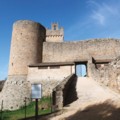
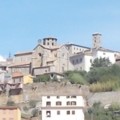
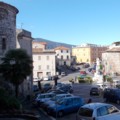
The attack
The assailants entered
Anagni on September 7th, 1303 at dawn or just before
(mane ante auroram) (manuscript of Vienne), and found the gates open, perhaps due
to a betrayal by some Anagni citizens, including Adinolfo Di Matteo
(also mentioned as Di Papa), a bitter enemy of the pope, who in
May 1297, along with his brother Nicola, had to sell to the pope's
nephew Pietro Caetani, known as the Marquis, the palace in Anagni
where later Pietro himself was besieged. According to Giovanni
Villani, the nobles and the citizens of Anagni were corrupted
by Nogaret's money, and on the other hand many of the Italian
conspirators were on the payroll of the French king. The chronicler
Ferretto Vicentino identifies Goffredo Bussa (Sigonfredus de
Bussa), commander of the pope's guards, as the self-confessed
responsible for handing in the keys (Giammaria, 2004).
The conspirators burst into the city wielding the fleurs-de-lis
banners of France and the papal insigna with the crossed keys
(Compagni), praising the king of France
and the Colonna, and inveighing against Boniface. The inhabitants
were awakened by the clamour, took to the streets and knew that
Sciarra Colonna wanted to capture the pope, so they rang their
bells to call a meeting; probably the people of Anagni agreed
in advance with the attack, having been harangued by the local
faction of the enemies of the pope, led by Adinolfo, that during
the meeting was elected captain of the city and to whom the elders
of the people swore right away fidelity, promising to follow his
orders.
After the meeting the attackers splitted (Fedele, 1921a): a part, led by Sciarra Colonna, attacked
the pope's palace and that of his nephew, the Marquis Pietro Caetani, which was fiercely defended by
the occupants, throwing stones and shooting crossbows (De horribili
insultatione), while
another group was commanded by Rinaldo da Supino, captain of Ferentino
and member of the Conti family (however brother-in-law to Francesco
Caetani), with the children of Goffredo da Ceccano, who had been
imprisoned by the pope, with Adinolfo and Nicola Di Matteo and
Massimo di Trevi. This group attacked the palaces of three cardinal
considered friends of the pope, Pedro Rodríguez Quijada,
bishop of Burgos (reported as Pietro Roderici or as "the
Cardinal of Spain"), Francesco Caetani, nephew of the
pope and Gentile Portino
da Montefiore (1240-1312), Franciscan cardinal of S. Silvestro
and S. Martino ai Monti, penitentiary of the pope. According to
other sources also the palace of Theodoric of Orvieto was assaulted.
The Cardinals saved themselves by fleeing from the back of their
palaces, through the outhouse, but their dwellings were stripped
of all goods.
The failure of the defense pushed Boniface to call for a truce,
which was granted by Sciarra until the ninth hour, that is until
early afternoon. During the truce, the pope would have sent messengers
to the Anagni people, promising them rewards if they had helped
him, but the response of his fellow citizens was that they relied
on Adinolfo's will, to whom they had entrusted the fate of the
city.
The pope then asked Sciarra what were the wrongs he complained,
offering a reparation, but the answer was that the compensation
had to be the delivery of all the treasure of the Roman Church
in the hands of two or three deans of the College of Cardinals,
Pietro and Giacomo Colonna and all other Colonna in their spiritual
and material powers, the renunciation of the papacy and the surrender
of the pope himself to the Colonna. The comment of the pope to
these terms was: "alas what a tough speech".
Further mediation did not bring any results, so Sciarra and his
men set fire to the gates
of Santa Maria cathedral,
which was an obstacle to the attackers, moreover robbing religious
and lay people, especially cutlery merchants, which were in the
vicinity. Inside the cathedral
the Hungarian archbishop of Esztergom, Gergely Bicskei was murdered,
killed by Orlando di Luparia from Anagni, son of Pietro, perhaps
for a personal retaliation.
The current topography of Anagni doesn't comply with the dynamics
of the events described by witnesses of the time: nowadays a large
square lies between
the Cathedral and the palace identified as that of Boniface, which
doesn't allow to think that the church was actually an obstacle
for those who intended to besiege the pope's palace. According
to Fedele
(1921a) the misunderstanding comes from
a misinterpretation of the Latin chronicle, and the burning of
the cathedral and the assault on the pope's palace were two separate
incidents.
At this point the marquis Pietro Caetani surrendered, and was
imprisoned in his palace in exchange for the safeness for himself
and for his children, Roffredo, said "il Conticello"
(the little count) and Benedetto, who also had tried to escape,
and were detained in the house of Adinolfo Di Matteo (Fedele, 1921a). Cardinal Francesco Caetani,
another nephew of the pope, had run away disguised as a valet,
in a place near Anagni, but still was caught on the same day (Fedele, 1921a). The assailants, once had broken
doors and windows, burst into his palace, setting it on fire in
several places.
Nogaret maintained, in a testimony given in Paris exactly a year
after the attack, that he didn't take part in the initial phase
of the attack, because he found himself far away from the papal
palace, perhaps in the house of Adinolfo, in order to negotiate
with the marquis Pietro the capitulation of the pope, and for
personal necessities ("propter necessitatem suae personae")
(Fedele,
1921a).
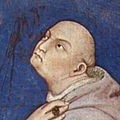
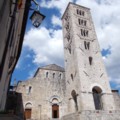
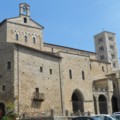
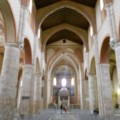
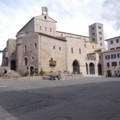
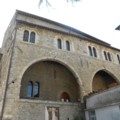
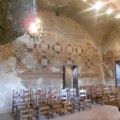
The slap
In the palace
of Boniface VIII at Anagni the "slap
hall" is shown, where it's told that the incident occurred,
but not all the contemporary sources report a real blow given
to the pope when he was arrested, and therefore the "slap
of Anagni" should be taken figuratively, as
a serious humiliation inflicted to the head of the Church of Rome.
Cardinal Niccolò di Boccassio, the future pope Benedict
XI, who told the facts as if he had been present, however, refers
to a real slap (“manus in eum injecerunt impias”),
other sources report an assault with insults and bitter threats,
to which the pope would not have replied.
If a slap was actually
given it should probably be attributed to Sciarra Colonna, who
at least would have tried to give it, though he was stopped in
time. In the Chroniques de Saint-Denis the attempt by Sciarra
to kill the pope is mentioned, driven by the hatred of his family,
and blocked by Nogaret, who boasted of having saved him twice
from the death and even not to have touched him nor having allowed
that anybody touched him ("persona eius nec tetigi nec
tangi feci") (Fedele,
1921a) also because
he was anxious above all to consign the pope alive to Philip IV.
In the same chronicles is told that the pope was wounded in the
face by a Colonna knight, while Dino Compagni (1255-1324) talks of an injury to the pontiff,
that however would have occurred in Rome and was followed by the
death of the pope (he was led to Rome where he was wounded
in his head, and after some angry day he died) (II, XXXV). Dante Alighieri in his Divine
Comedy doesn't mention Nogaret, just like the chronicle of
St. Alban, that just talks about Sciarra. It seems clear, however,
a contrast between the Colonna, with their local allies and the
French on what to do, that is whether killing the pope or consigning
him alive to the king of France. Sciarra would have then returned
to the fray, slapping the pope even with a chain mail glove, managing
to hit him and perhaps breaking his nose. William Hundleby wrote
that the pope didn't suffer any physical harm, but perhaps he
referred to visible damage (Lefèvre).
The attack occurred at the hour of vespers (around six in the
evening); according to a version of the facts Boniface tried to
feign to be dead to escape the arrest, but the strong character
of the Pope suggest a more credible version, reported by Giovanni
Villani, referring that the pope had waited for the conspirators
sitting on the papal throne, wearing all the symbols of the papal
power, and holding a crucifix, which he kissed repeatedly. According
to the chronicle of Orvieto instead the pope was lying in bed
when the assailants found him.
Nogaret, as seen, intervened later, and ordered the Pope to follow
him in Lyon, where a council summoned by the king would have to
depose him. The assailants had repeatedly ordered the pope to
renounce the throne, but the pope responded "Ec le col,
ec le cape", that is: "here's my neck, here's
my head", meaning that he would die rather than abdicate.
Boniface also said: "Nosco primogenitum sathane",
that is "I recognize the firstborn of Satan",
probably referred to Nogaret (Giammaria, 2004).
The pope also apostrophized Nogaret defining him as "son
of Cathars", actually the Cathar minister Raymond de
Nogaret, condemned as an heretic at the time of the Albigensian
crusade, though not burned at the stake, could have been Guillaume's
grandfather (Dossat). Boniface knew Nogaret because
this had been sent by Philip IV as ambassador by the Pope in 1300;
Nogaret had left a lively and colorful report of this experience.
It seems that only three or four members of the court of the pope
remained with him, including Cardinal Nicholas of Boccassio, who
became his successor, and the Cardinal of Spain, who was so faithful
to him, that wanted to be buried at his feet (ad pedes dominus
sui), two cubicularii, attendants in the personal service
of the pope, a knight hospitaller and a knight templar, Giacomo
Pocapaglia and Giovanni Fernandi, while others were killed or
fled or joined the assailants shouting "long live the
king of France and the Colonna, death to the pope and to the marquis"
referring to Pietro Caetani, the pope's nephew. The attackers
also plundered the property of the pope and the Caetani, so that
the papal coffers were completely emptied and clothes, furnishings,
gold and silver and all that they found were stolen. The attackers
would have outraged the relics and damaged many documents from
the archive of the pope (Tabularium)
(Giammaria,
2004). According to
Nogaret the sacking of the apartments of the pope was also made
by the relatives and servants of the pope. Also the houses and
the people of the Castello district, where the papal and the Caetani
palaces lie, underwent looting (Giammaria, 2004). Also Symon Gerardus, banker of the pope
was robbed of everything and barely saved his life. According
to Hundleby no sovereign in the world bestowed in one year the
riches that were stolen from the palaces of the pope and his associates
in a few hours. According to estimates, the pope during his pontificate
had amassed a fortune: 2,265,000 florins of income. As Boniface
was informed about the pillage, commented: "Dominus dedit,
Dominus abstulit" (God gave it to me, God took it out).
The pope was locked in his room and guarded by numerous armed,
but without being tied or chained; according to another chronicle
he was imprisoned in the palace of Rinaldo da Supino.
Fawtier notes that references to the facts of Anagni are lacking
in other contemporary documents, and considers it an evidence
of the little importance given at the time to this incident. Fedele
(1921a) thought
instead that the attack against the pope aroused great emotion
in Italy, as testified by Dante and several other contemporary
sources. Cardinal Jacopo Gaetano
Stefaneschi (1270-1343), who was not present at the outrage,
in his Opus metricum, describes the event as a "great
accident, sorrowful and iimmoral" (gravis alluvies,
funesta et morbida).
The liberation
Monday, September
9th, after three days of captivity in the palace
of Anagni, Boniface and the marquis Pietro were freed by the armed
Anagni population, that this time shouted "long live the
pope, death to foreigners!" and drove the invaders out,
with clashes that caused several casualties. The change of side
of the inhabitants of Anagni seems to have occurred in the course
of an assembly, to which neither Adinolfo nor the Colonna took
part, which was convoked after the news that the attackers wanted
to kill the pope was known. In the course of the meeting, among
the inhabitants the fear arose of exposing Anagni before all Christendom
as the city that had allowed the pope's capture, although he had
done many wrong things in life, and it seemed that the best thing
to do was then attacking the papal palace, moreover swearing that
if the pope's jailers appointed by the captain and by Sciarra
had opposed any resistance they hadn't left anyone alive. The
action was probably very quick: between the assembly, held at
nine, and the liberation of the pope only three hours passed (Giammaria, 2004).
Some believe that even the brutality, and in particular the pillage
of the assailants soldiers towards Anagni people had contributed
to the change of side of the population (Tolomeo da Lucca). Hundleby
talks of a force of 10,000 armed men, but it seems excessive,
since Anagni had a few thousand inhabitants (they were 3,200 in
1420). The liberators found resistance, but in the end, around
noon, they were able to enter and drive out the occupiers, who
had many losses; many people, in order to escape, jumped out of
the window. Sciarra and his family were expelled from Anagni,
among insults and threats of the inhabitants, while it's told
that Rinaldo and Roberto di Supino, Adinolfo di Matteo and many
others were captured. According to others also Nogaret was wounded
(Orvieto
manuscript) and forced
to flee in Ferentino, while the French flag with the fleurs-de-lis
would have been dragged through the mud (Giammaria, 2004).
Also the palaces of the pope's nephews were liberated. When a
group of Anagni people was admitted to the pope's presence, one
of them spoke on behalf of them all, asking him to allow them
to guard his person until he was in danger. The pope raised his
eyes and hands to heaven thanking God and the citizenry for having
freed him from the danger of dying. The pope was brought by the
Anagni people, who shouted "Long live the Holy Father!",
to the cathedral square, adjacent to the palace, where he weeping
thanked God and all the saints and the people of Anagni for saving
his life. Boniface later asked for food and beverage since he
was still whitout food, promising in exchange for absolution and
forgiveness. The building was then invaded by a parade of people
that brought him wine and food. According to Nogaret, however,
the pope had had access to food and drink, and maybe he had not
eaten for fear of being poisoned or to protest against the imprisonment.
Boniface allowed everyone who entered the building to talk to
him, and complained of having being left deprived of all good,
poor as Job; he specifically forgave all those who had stolen
the goods of his own fortune, and would have acquitted anybody
except for the plunderers of the properties of the church of Rome,
of the cardinals and the other members of the curia, unless they
had returned the stolen goods within three days. Part of the stolen
goods were actually given back, but much remained in the hands
of the plunderers. Boniface freed Rinaldo da Supino (Giammaria, 2004) and promised to make peace with
his enemies, particularly the Colonna, and to reintegrate them
into their material and spiritual goods.
The outcome of the Anagni crisis had repercussions throughout
the area, up to Naples, with clashes between the Caetani and their
allies against the enemy families who had retrieved the territories
conquered by the Caetani (Giammaria, 2004).
The death
The pope remained
in the custody of the city hall of Anagni, until September 12th
(or 13th) when unexpectedly and suddenly
he returned to Rome, that he deemed the only place where he could
save himself, given the large number of enemies who antagonised
him. He moved escorted by a large number of his armed supporters,
perhaps 400 (Guigniaut,
De Wailly). This following arrived at Anagni to the
rescue of the pope and contributed to his freeing (manuscript of
Padua). The pope spent
the night in the Lateran papal palace where he stayed for two
days and the third day he moved to St. Peter. But even in Rome
the situation was critical, even if the powerful Orsini
family, a traditional rival of the Colonna, was then completely
sided with the pope.
The Orsini historically controlled the north of Rome and the adjacent
Campagna areas, on the roads Flaminia, Salaria and Cassia, while
the Colonna, before the expansion of the Caetani, maintained the
control of the south of the city and of the areas around the roads
Appia, Prenestina and Casilina.
Many Romans were, however, against the pope and supported the
Colonna, the senators of Rome had resigned, no judge was administering
the law and everyone had to fend for themselves. The pope, terrified
and traumatized, had barricaded himself in St. Peter's palace
without receiving anyone, while the Vatican Curia was blocked,
and no one could escape the city because on all sides there were
bandits who robbed the passers-by. The pope, already suffering
from kidney stones, died about a month after the slap on the night
between 11th and 12th
October 1303. Giovanni Villani (IX, 63)
told: "the
pain petrified in the heart of pope Boniface for the insult he
received, caused him, as he reached Rome, a different sickness,
so that he gnawed himself as if she were rabid, and in this state
he passed away from this life".
The next day the pope was buried in St. Peter's Caetani chapel,
in a funerary monument (see photo1,
photo2 and survey)
made by the great Arnolfo di Cambio. It is said that the day of
the funeral a furious storm raged. This would also have happened
at Orvieto, on the day he celebrated his first mass, as reported
by the manuscript of Orvieto, and, in verse, by Jacopone da Todi
("When your first mass was then celebrated, the darkness
fell throughout the territory, neither a lamp in the church was
left illuminated, such a storm raged, where you had celebrated")
(83:
35-38). These meteorological phenomena,
supposing they actually occurred, were evidently interpreted as
negative omens. Actually in Italy the autumn storms, including
violent ones, are not rare, let alone supernatural.
The end of Boniface VIII, the last of Anagni popes, also caused
the decline of the city, almost making true the curse of Benedict
XI, Boniface's successor, against his native town, which didn't
defend him: "may the dew and the rain no longer fall upon
thee; may they descend on other mountains because you , as
a spectator and having the might to impede it, you left that
mighty man fall and that belt of strength was overwhelmed"
(Giammaria,
2004).
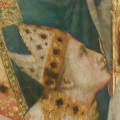
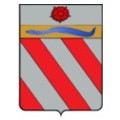
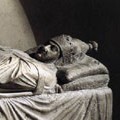
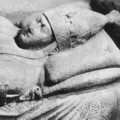
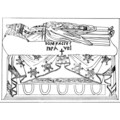
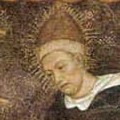
Dante
and Boniface
Dante Alighieri also
speaks of the Anagni slap in the Divine Comedy (Purgatorio, XX, 85-90):
"to make the
past and future evil look lesser, I see the fleur-de-lis burst
into Anagni, and / instead of his Vicar Christ being seized. /
I see him once more being mocked; / I see again the vinegar and
gall, / and him amid alive robbers being killed".
The first-person narrator is Hugh Capet (941-996), founder of the dynasty of the
Capetians ("root of the wicked plant") (id., 43), ancestor of Philip the Fair.
Dante deplored the insult made by the France ("fleur-de-lis")
to the Pope, in so far as Vicar of Christ, considering it an offense
made to the same Christ by the king ("the new Pilate"),
almost a new crucifixion, perpetrated with the support of the
king, in spite of the subsequent dissociations ("the new
Pilate") (id.,
91). The verses echo
the speech delivered in Perugia by Benedict XI, the successor
of Boniface, on the occasion of the emanation of the bull of excommunication
against the aggressors of Anagni. According to Fedele (1921a), Dante was present at the event,
and was inspired by it.
All this despite the poet was decidedly hostile to Boniface VIII,
who indirectly favored his exile from Florence, supporting the
Black Guelph faction, and to the papal Curia, accused of trafficking
in divine things ("where every day Christ is bought and
sold") (Paradiso,
XVII, 51).
Moreover Dante placed Boniface in his Comedy's Inferno, in the
third Bolgia
(XIX,
76-87), between the
simonists, those who traded sacred things, who expiate their guilt
being thrust in the ground upside-down and with their feet on
fire. Dante places Boniface's arrival to hell in a period subsequent
to his visit, and the event is foretold by Pope Nicholas III,
who is in his turn condemned, and who announces the next arrival,
in addition of Boniface, also of Clement V, defined as "a
shepherd with no law" (id., 83).
Pope Nicholas, talking to Dante, but thinking to speak to Bonifacio,
asks him whether he isn't already sate of those riches for which
he didn't fear to deceive and plunder the Church of Rome ("the
beautiful woman") "Se’ tu sì tosto
di quell’aver sazio, per lo qual non temesti tòrre
a ’nganno, la bella donna, e poi di farne strazio?"
("are you finally sate of those riches, for which you
weren't afraid to deceive the beautiful woman, and then to torment
her") (id.,
52-57). Dante also
gets Saint Peter's talk, defining Boniface as "The one
who usurps my place on earth, my place, my place, my vacant place,
in the presence of the son of God, made of my cemetery a sewer
of blood and stench, where the perverse who tumbled down from
here, appeases himself", with the last verse referring
to the Devil, who delights in the corruption of the Church (Paradiso, XXVII,
22-27). Even the verse: "the bride
of Christ was not raised / on my blood, on Linus', or Cletus'
/ to be used to purchase gold" (id, 40-42) is a polemic against Boniface VIII for
his tendency to enrich himself benefitting from the office of
pope, in opposition to the early popes, Peter, Linus and Cletus,
who had given blood for the Church.
In another canto, Dante entrusts the troubadour and bishop Folquet
de Marselha the task of cursing the lust for money that, arisen
from Florence, had corrupted the pope and cardinals, so that they
didn't take care of the religion any more: "do not go
their thoughts in Nazareth, there where Gabriel opened the wings"
(Paradiso,
IX, 136-138). The
pope, although not explicitly mentioned, is Boniface VIII, and
the poet foresees his imminent end: "But the Vatican and
the other distinguished parts of Rome, which have been the cemetery,
for the rank that followed Peter, shall soon be free from the
adulterer" (id,
139-142).
Another reference to Boniface is in Canto XXVII of Inferno, where
Guido da Montefeltro blames the pope for having pushed him to
fall again into sin ("the High Priest, evil to him!, that
set me back on my former sins") (70-71), earning eternal damnation. Guido had redeemed
himself from a sinful life as a mercenary captain, becoming a
monk, but Boniface had forced or persuaded him (by promising absolution)
to make his expertise available, giving advice ("fraudulent
advice") (id.,
116) on how to conquer the Colonna
stronghold of Palestrina, among other promising clemency to the
inhabitants in case of surrender, and then not honoring his pledge. A
part of the historians doesn't believe that this betrayal actually
occurred (Fedele,
1921b). Guido blames
Bonifacio also for having made war to the "neighbors"
Colonna, instead of fighting against the followers of other religions:
"the Prince of the modern Pharisees makes war near the
Lateran, and not against Saracens nor with the Jews"
(id,
85-87).
After
the slap
After the Anagni slap
and the death of Boniface VIII, the contrast between the Church
and Philip the Fair diminished, but the new Pope Benedict XI,
the Dominican from Treviso Niccolò Boccassio, who as a
cardinal had possibly witnessed the assault of Anagni, in a bull
of November 6th, 1303, fifteen days after his
election as pope, and after two months from the outrage, blamed
the "many children of iniquity, the firstborn of Satan
and disciples of iniquity" who had "brutally
beaten up" his predecessor and robbed him the treasury
of the Church. If these sacrilegious had not given the stolen
goods back, they would have been excommunicated at the sound of
the bells and with the candles blown out (Fedele, 1921a).
Benedict had instead left the conspirators out from the general
absolution of May 12th, 1304 and had explicitly condemned
them with the bull Flagitiosum scelus of June 7th,
1304, issued from Perugia, excommunicating the fifteen ringleaders
of the conspiracy, holding them up to the revenge of Christianity,
and condemning the city of Anagni, that had allowed the insult
to the pope. With the bull, the pope summoned the excommunicated
to his presence for June 29th, St. Peter and Paul's day, for
having laid hands on the pope, attacking him also verbally with
blasphemous and outrageous sentences. On the same day, in a square
of Perugia, the pontiff had spoken to the crowd, blaming the attack
made to the vicar of Christ, comparing his fate to that of Christ
in the hands of Pilate and his soldiers.
The pope anyway eased the conflict with Philip the Fair, treating
him as legitimate sovereign, since in any case the excommunication
had not been published. A month before was maybe the same Boccassio
who induced Boniface VIII to forgive his attackers, in his speech
to the people of Anagni after his liberation.
The reaction of Anagni people to the anathema of the new pope
was a trial, filed against the participants to the aggression
against Boniface, who were banished forever from Anagni, under
penalty of decapitation if they returned, and all their goods
were confiscated. These sanctions were not subject to revocation,
but whoever had proposed to the council or to the parliament the
recall in the city of the convicted, would have been sentenced
to a fine of a thousand florins, or to decapitation. This sentence
was probably markedly influenced by Pope Benedict's bull (Fedele, 1921a).
The bull Flagitiosum scelus caused big reactions in Europe,
on June 23rd the King of Naples Charles II
of Anjou inveighed against the detestable naughtiness (detestabilis
malignitas) defined as execrable hazard ("exsecrabilis
ausus") committed against Pope Boniface, prohibiting
with threats his subjects to support the conspirators and ordering
to denounce those of them who had taken refuge in the kingdom
and to seize any property stolen to the treasury of the Church
(Fedele,
1921a).
The situation turned in favor of France when on July 7th,
1304, a month after the bull, the brief pontificate of Benedict
XI ended in Perugia: the pope died of indigestion from figs. Villani
(IX,
80) refers
of rumors of poisoning by a man, disguised as a woman in order
to appease his mistrust, who had offered the pope figs. The new
conclave after eleven months (June 5th, 1305) elected as pope, with
the name of Clement V, the archbishop of Bordeaux, Bernard de
Got (1264-1314), who transferred the papacy to
Avignon, where it lasted until 1377. On December 17th,
1305, the pope reinstated Giacomo Colonna on his cardinal's jurisdiction
and so did on 2nd February, 1306 with Pietro Colonna,
and on March 25th, 1307 overturned or even ignored
the condemnations against the King of France, with the bull Tunc
navis Petri.
On April 27th, 1311 Guillaume of Nogaret obtained
from Clement V, with the bull Rex gloriae, (or "Ad
certitudinem praesentium") the absolution "ad
cautelam" for the participants of the Anagni incident,
which had been denied by his predecessor, distinguishing the imprisonment
(the «captio») from the physical aggression
(«aggressio vel insultus tactus in Bonifacium»).
Clement agreed the destruction of the papal documents against
the king, abrading the dangerous parts or cutting whole pages
(Frale). With the bull the King of France
was ordered to pay the costs of the trial, set in 100,000 gold
florins. Nogaret had been gratified by the king for the endeavour,
with the allocation of a large amount of money and land.
In exchange for the absolution, the Pope asked the participation
at the next crusade and a certain number of pilgrimages in Spain
and France. However Guillaume didn't do anything of that.
In order to avoid the danger of a possible publication of the
bull of excommunication, Philip the Fair, brought a case against
the late Boniface VIII to prove he was a heretic and therefore
to make his body burn, so as to nullify the effects of the bull.
At the trial, which began in Avignon in September 1309, attended
many witnesses caming from Italy, who anyway harboured bitterness
towards Boniface VIII and who reported episodes of witchcraft
fitting even too much to the stereotype of the topic and telling
of blasphemous and heretical phrases said by Benedetto Caetani
before and after his election to the papacy, releasing testimonies
so much similar among them that they seemed arranged.
Both Rinaldo da Supino and Guillaume de Nogaret tried to dissociate
themselves from Sciarra Colonna, and then from the violence against
the pope. Rinaldo avoided to mention Sciarra, while Nogaret denied
that he was aware of the contrasts between the pope and the Colonna
(Fedele,
1921a, 1921b).
Clement V opposed the posthumous condemnation of his predecessor
Boniface, that would have cancelled all his deeds and his decisions,
including those with civil effects, with serious damage to many
citizens. The charges were of blasphemy, atheism, sorcery, sodomy,
lust, abusing children and having impregnated two nieces, whose
children he had later appointed cardinal. No credible evidence
had been brought to these allegations. In the summer of 1310 Clement
opposed to allegations of a sexual nature which, by the way, weren't
in tune with the advanced age of the pope, and urged to focus
only on the charges of heresy.
The sources
The facts of Anagni
are described in different narrations, some of which appear as
written by witnesses of the events:
- Flagitiosus scelus. bull of pope Benedict XI, in the world Niccolò di Boccassio, successor of Boniface VIII, who was then Cardinal and tells the facts as they occurred before his very eyes (in nostris etiam oculi).
- De horribili insultatione et depredatione Bonefacii pape. British Museum Manuscript Reg. XIV, c., I, published in Paris in 1872 by baron Joseph Kervyn de Lettenhove on the Revue des question historiques. The manuscript was made in St Albans Abbey, near London, by the Benedictine monk William Rishanger, known as "Chronigraphus", who had copied it at the end of his annals of the reign of Edward I. The unknown author describes the events as if he had been there and refers he was born in Cesana. In Italy there are three places named Cesana, one in Piedmont, in the Susa Valley, one in Lombardy, province of Lecco, and one in Veneto, province of Belluno. However it is possible that the reference is wrong, and the author was born in Cesena, in Romagna.
- Vienne Manuscript. Drawn up by a person who defines himself a member of the papal court and eyewitness of the events of Anagni, probably between 1306 and 1311. It would therefore be a narration of events he lived a few years before, but based on a letter written in the immediacy of the facts, since it doesn't mention the death of Boniface VIII, occurred just over a month after the Anagni assault. It was purchased in Vienne (Dauphiné, France) in 1696 and became part of the collection of Jean Caulet bishop of Grenoble, and then of the Library of the same city of Isère department.
- Memorandum quod anno domini M°CCC° tercio. A report written on September 27th, 1303 in Rome by William Hundleby, solicitor at the Roman Curia of the bishop of Lincoln John Dalderby and kept at the British Museum (Manuscript Royal CI, fol. 12) and at All Souls College, Oxford (manuscript 39 , fol 117b-120b). The source doesn't mention Guillaume de Nogaret.
- Nuova Cronica. by Giovanni Villani (1276–1348), Florentine, compiled since 1300, according to the author, that does not declare to be an eyewitness of the slap.
- Ferreti, poetae vicentini, suorum et paulo ante actorum temporum historia, by Ferretto Vicentino (Ferreto dei Ferreti, 1297-1337). Obviously he doesn't write as an eyewitness, for a question of age, and oftentime reports inaccurate news.
Bibliographic references:
BASSETTI
Sandro (2007) Il cardinale Theodorico de' Ranieri. Lettera
Orvietana, 18-19-20, agosto 2007: 8-9. (link)
BECK Henry G.J. (1946) William Hundleby's account of the Anagni
outrage. The Catholic Historical Review, 32: 192-199. (link)
BEZZINA Denise (2018) Spinola, Porchetto. In: Dizionario Biografico
degli Italiani - Volume 93. Istituto dell'Enciclopedia Italiana
Treccani, Roma. (link)
BOUTARIC Edgard (1872) Clément V, Philippe le Bel et les
templiers. Revue des questions historiques, XI: 7-42. (link)
COMPAGNI Dino (1310-12) La cronica: delle cose occorrenti ne'
tempi suoi. In: Isidoro del Lungo - La cronica: di Dino Compagni
delle cose occorrenti ne' tempi suoi. Successori Le Monnier, Firenze,
1908. (link)
COSTE Jean (1993) Les deux missions de Guillaume de Nogaret en
1303. Mélanges d'archéologie et d'histoire, Moyen-Age,Temps
modernes, 105 (1): 299-326. (link)
CHACÓN Alfonso (1601) Vitae et Gesta Summorum Pontificum,
a Christo Domino usque ad Clementem VIII, necnon S. R. E. Cardinalium
cum eorundem insignibus. Stefano Paolini, Roma. (link)
CRONICA URBEVETANA () in Rerum Italicarum scriptores. (in appendice
a Ephemerides Urbevetanae). XV, 5 199-204. Nicola Zanichelli,
Bologna, 1902-1920.
DANTE ALIGHIERI (1304-1321) La Divina Commedia. Rizzoli, Milano,
1995.
DIGARD Georges A. L. (1888) Un nouveau récit de l'attentat
de Anagni, Revue des questions historiques, XLIII: 557-561.
(link)
DOSSAT Yves (1941) Guillaume de Nogaret, petit fils d' hérétique.
Annales du Midi, 53 (212): 391-402. (link)
DUPRÉ THESEIDER Eugenio (1971) Bonifacio VIII, papa. In:
Dizionario Biografico degli Italiani - Volume 12. Istituto dell'Enciclopedia
Italiana Treccani, Roma. (link)
DUPUY Pierre J. (1655) Histoire du différend d' entre le
Pape Boniface VIII et Philippes le Bel , Roy de France. Sebastien
et Gabriel Carmoisy, Paris (link)
FAWTIER Robert (1948) L'attentat d'Anagni. Mélanges
d'archéologie et d'histoire, 60: 153-179. (link)
FEDELE Pietro (1921a) Per la storia dell'attentato d'Anagni. Bullettino
dell'Istituto Storico Italiano, 41: 195-232.
FEDELE Pietro (1921b) Rassegna delle pubblicazioni su Bonifazio
VIII e sull'età sua degli anni 1914-1921. Archivio della
R. Società Romana di Storia Patria, 44: 311-332.
FERRETTO VICENTINO (Ferreto dei Ferreti) () Historia Rerum in
Italia Gestarum, ab anno MCCL ad annuum usque MCCCXVIII. In:
CIPOLLA Carlo (1908) Le opere di Ferreto de' Ferreti Vicentino.
Istituto Storico Italiano, Roma.
FRALE Barbara (2013) L'inganno del gran rifiuto. UTET, DeAgostini,
Novara.
GIAMMARIA Gioacchino (1983) Bonifacio VIII in Anagni nell'anno
del primo giubileo. Romagnoli Editore, Anagni.
GIAMMARIA Gioacchino (2002) Gli studi bonifaciani di Pietro
Fedele. Istituto di storia e di arte del Lazio meridionale,
Anagni.
GIAMMARIA Gioacchino (2004) Lo schiaffo a Bonifacio VIII e
altre ricerche di storia medievale anagnina. Istituto di storia
e di arte del Lazio meridionale, Anagni.
GRAZIANI Gerum (2001) Sgurgola nel medioevo: storia di un
castello di origini longobarde. Ferrazza & Bonelli, Colleferro.
(link)
GUIGNIAUT Joseph-Daniel, DE WAILLY Natalis (curatori) (1855)
Recueil des Historiens des Gaules et de France. Tome Vingt et
Unième. Imprimerie Impériale, Paris (link)
JACOPONE DA TODI () Laude. Letteratura Italiana Einaudi. (link)
KERVYN DE LETTENHOVE Joseph (1872) Une relation inédite
de l'attentat de Anagni. Revue des questions historiques,
XI: 511-520. (link)
LEFÈVRE André (1904) L'aventure de Boniface VIII.
Revue de l'école d'anthropologie de Paris, 14: 5-88.
(link)
MADDALO Silvia (1992) Bonifacio VIII. In: Enciclopedia dell'Arte
Medievale. Istituto dell'Enciclopedia Italiana Treccani,
Roma. (link)
MIRANDA Salvador (2015) The Cardinals of the Holy Roman Church.
Biographical Dictionary (link)
NANGIS (de) Guillaume () Chronique latine de Guillaume de Nangis,
de 1113 à 1300, avec les continuations de cette chronique,
de 1300 à 1368. Jules Renouard & cie., Paris,
1843. (link)
NEWHALL Richard A. (1921) The affair of Anagni. The Catholic
Historical Review, 7 (3): 277-295. (link)
PARAVICINI BAGLIANI Agostino (1994) Il corpo del papa. G. Einaudi,
Torino.
PARAVICINI BAGLIANI Agostino (2003) Bonifacio VIII. Einaudi,
Torino.
PARTNER Peter (2000) Il mondo della Curia e i suoi rapporti con
la città. In: "Storia d'Italia, Annali, 16 - Roma,
la città del papa" edited by Luigi Fiorani and Adriano
Prosperi. Einaudi, Torino. pag. 203-240.
STEFANESCHI Jacopo Gaetano (1319) Opus metricum. F.-X. Seppelt,
1921 (link)
THÉRY Julien (2003) Allo scoppio del conflitto tra Filippo
il Bello di Francia e Bonifacio VIII: l’affare Saisset (1301).
Atti del convegno di studi per i 700 anni dalla fondazione
dell'Università degli Studi di Roma ‘La Sapienza’
(Roma/Anagni, 9-10 maggio 2003). (link)
TOLOMEO DA LUCCA () Manoscritto di Padova, In Rerum italicarum
Scriptores, a cura di Ludovico Antonio Muratori. (1727) XI
1223C
TOMASSETTI Luigi (1857-72) Bullarium romanum. Franco, Fory
e Dalmazzo, Torino. (link)
TOSTI Luigi (1846) Storia di Bonifazio VIII e de' suoi tempi.
Montecassino. (link)
VACCOLINI Domenico (1840) Bonifacio VIII. L’album, Giornale
letterario e di Belle Arti, VII, 34, 24 ottobre 1840: 269-271.
VILLANI Giovanni (1348) Nova cronica. Da: "Nuova Cronica,
a cura di G. Porta, Fondazione Pietro Bembo/Guanda, Parma, 1991.
(link)
WALEY Daniel (1973) Caetani, Francesco. In: Dizionario Biografico
degli Italiani - Volume 16. Istituto dell'Enciclopedia Italiana
Treccani, Roma. (link)
WALTER Ingeborg (2000) Benedetto XI, beato Enciclopedia dei
papi, XI: 511-520. Istituto dell'Enciclopedia Italiana
Treccani, Roma. (link)
related websites:
https://casatoranieri.wordpress.com/page/2/
http://it.wikipedia.org/wiki/Giacomo_Sciarra_Colonna
http://www.araldicavaticana.com/pbonifacio08.htm
https://www.comune.anagni.fr.it/
https://www.galleriacolonna.it/en/the-colonna-family/
http://www.palazzobonifacioviii.it/
https://www.corrispondenzaromana.it/bonifacio-viii-il-papa-del-primo-giubileo/
Webpage not available (update May 26th, 2022)
http://perso.orange.fr/jean-francois.mangin/capetiens/capetiens_7.htm
 page
created: November
23rd, 2011 and last updated:
May
26th, 2022
page
created: November
23rd, 2011 and last updated:
May
26th, 2022